A Private Tour today from Titchwell Manor. It was a glorious start to the day, sunny and clear, and it warmed up through the morning.
We started with a short drive up to the fields behind the hotel. It didn’t take us long to find the Dotterel, though they were a little distant again across the field. There were at least seven of them, though they were hard to count – they kept freezing and back on or crouched down in the tramlines they were impossible to see. The females were looking particularly bright in the sun (Dotterel is a species where the role of the sexes, and their colours, is reversed). There were also lots of Skylarks singing and a couple of Brown Hares chasing each other round the field.
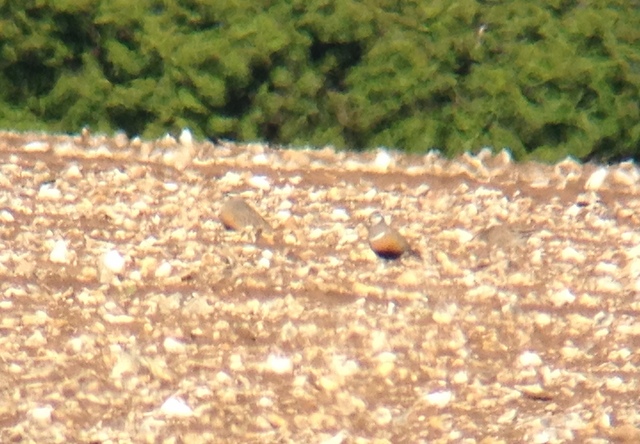 Dotterel – at least 7 still in the stony field at Choseley today
Dotterel – at least 7 still in the stony field at Choseley today
We drove on round to the other side to see if we could see any other of the local farmland specialities. On the edge of a field, by the road, we came across a little group of Yellowhammer and Corn Bunting feeding on the ground. We stopped for a better look, but unfortunately we had an impatient driver behind us who sounded his horn and the birds flew off. He was only heading down to see the Dotterel – they have been around for days, and he had plenty of time to stop and admire the Corn Bunting himself. At least we found another one singing on the wires a little further along, after we had pulled over to let him speed past – and we had the time to admire this one in peace.
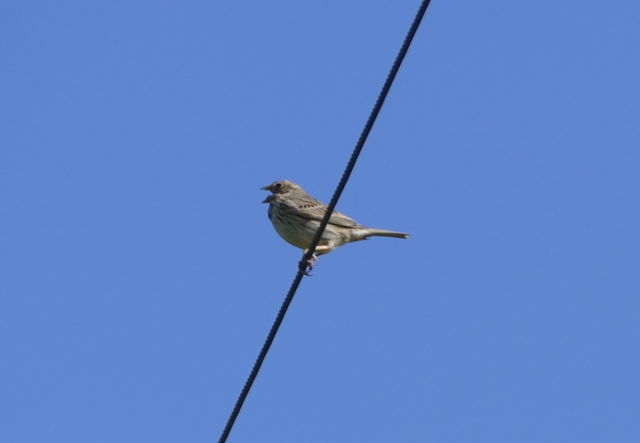 Corn Bunting – singing on the wires at Choseley
Corn Bunting – singing on the wires at Choseley
The Dotterel were no closer from the other side, but we did stop to scan the fields. Several Swifts were making their way west along the ridge. A Common Whitethroat sang from the hedge. And there were lots more Brown Hares.
Our next stop was at Holkham. There were quite a few cars already at Lady Anne’s Drive. It was always going to get busy on a sunny bank holiday, but most people were heading straight out onto the beach and it was quieter walking west inland of the pines. There were lots of warblers singing from the trees – Blackcaps, Whitethroats and Lesser Whitethroats, Chiffchaffs and Willow Warblers. From the reeds, we could hear Reed, Sedge and Cetti’s Warblers, though we couldn’t see any of them here. The regular resident birds were singing as well, though perhaps a little less enthusiastically than the newly arrived warblers – tits, Goldcrests and Treecreepers.
There were lots of butterflies out in the sunshine as well – Peacock, Speckled Wood, Orange Tip, Green-veined White, Holly Blue and several iridescent Green Hairstreaks.
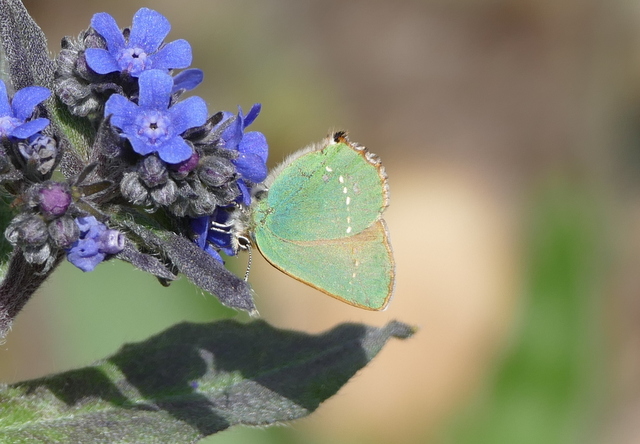 Green Hairstreak – several were at Holkham today
Green Hairstreak – several were at Holkham today
Before we even got to the Joe Jordan hide, we could see the Spoonbills on the pool below. There were at least five of them visible today – a pair feeding at the back of the pool and at least three birds flying backwards and forwards to the trees, collecting nest material.
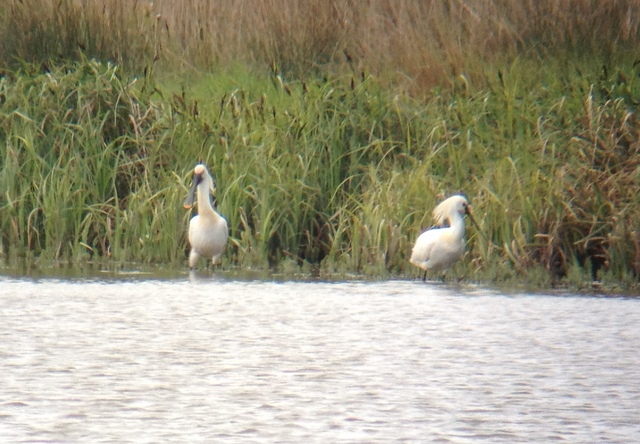 Spoonbills – lots of activity below the colony today
Spoonbills – lots of activity below the colony today
There were other things to see from the hide as well – the usual Marsh Harriers, Little Egrets and Cormorants. A few Swifts were moving west over the back of the grazing marsh. We paused to admire a smart couple of Red-legged Partridge in the grass below and spotted a pair of Grey Partridge nearby, creeping through the vegetation altogether more secretive, the male with his head raised watching while the female fed. We had also seen three Pink-footed Geese from the path on the walk out.
There was a little herd of cows on the top of the old fort and, hearing a distant ‘pseep’ call, a quick look revealed a yellow head in the grass nearby. A smart male Yellow Wagtail. Turning the scope onto them, we could see there were actually several of them, at least five, walking around amongst the cows’ feet.
We left the hide and continued our way westwards. We hadn’t gone much further when a ghostly shape appeared from the grass by the track and headed off silently along the path ahead of us. A Barn Owl. It had been a wet day yesterday, so perhaps it had struggled to find food, presumably with young mouths to feed. The Barn Owl kept flying ahead of us, disappearing into the trees or out over the grass, before reappearing again further on. When we got to the west end of the pines, we found it again, hunting over the edge of the grazing marsh. It quartered back and forth, occasionally dropping suddenly into the grass, but then coming back up empty-handed. Stunning.
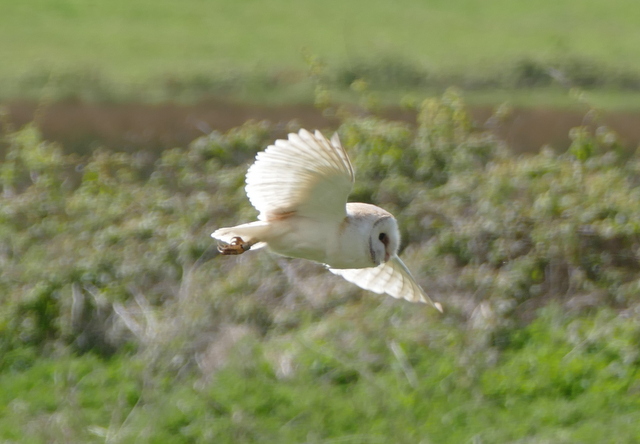 Barn Owl – hunting in the middle of the day today
Barn Owl – hunting in the middle of the day today
A Cuckoo appeared from the dunes and flew across the grazing marsh, landing on the fence in front of us. It started to ‘cuckoo’ – such an evocative sound, a real sound of spring.
The initial walk through the dunes was fairly quiet – a little flock of Linnets and a few Meadow Pipits. Then we rounded a corner and there, on the edge of the dunes but over the NNR fence, was a male Ring Ouzel. It froze for a second, before hopping quietly up and over the top of the dune and out of sight, unfortunately before we could all get a good look at it. Just a little further on and a second Ring Ouzel, this time a female, erupted from the bushes and flew off calling, towards where the male had disappeared.
There was a steady stream of Yellow Wagtails flying west all morning. Most of them we could only hear, their distinctive ‘pseep’ flight calls announcing their passing, but the odd one came close enough for us to see a long-tailed shape bounding overhead. Small numbers of Swallows were also passing constantly over the dunes. There were several Wheatears down on the short grass, including a smart, big, orange-breasted male Greenland Wheatear.
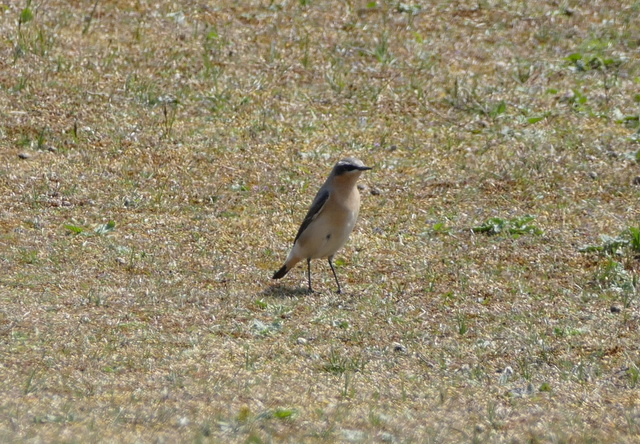 Greenland Wheatear – a nice, big, orange-breasted male
Greenland Wheatear – a nice, big, orange-breasted male
Unfortunately, we didn’t have time to walk all the way to Burnham Overy, so turned back at the top of the dunes, before we got to the boardwalk. As we got back to Lady Anne’s Drive, a couple of people kindly pointed us in the direction of yet another Barn Owl. This one was standing on a post, right by the path. It seemed oblivious to the small crowd which was gathering nearby to admire it. An even stranger time to see a Barn Owl out and about, in the middle of the day, on a warm, sunny spring day.
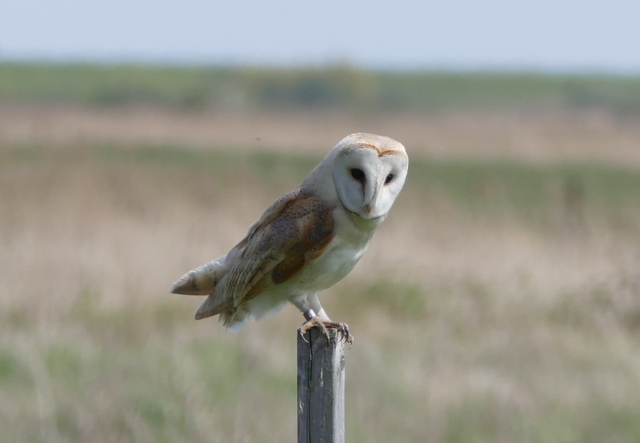 Barn Owl – on a post, oblivious to its admirers, in the middle of the day
Barn Owl – on a post, oblivious to its admirers, in the middle of the day
After lunch in the sun at Lady Anne’s Drive, we drove back to Wells. The beach car park was so full, they had closed the road in the morning and cars had been diverted into an overflow car park near the town! Thankfully, with some people having left for lunch, we were allowed to drive down to the end. From up on the harbour wall, we could admire the gull colony. Amongst the numerous Black-headed Gulls, we found a few smart, black-hooded Mediterranean Gulls, as well as quite a few lovely summer Common Gulls. There were also several Common Terns patrolling the muddy channels.
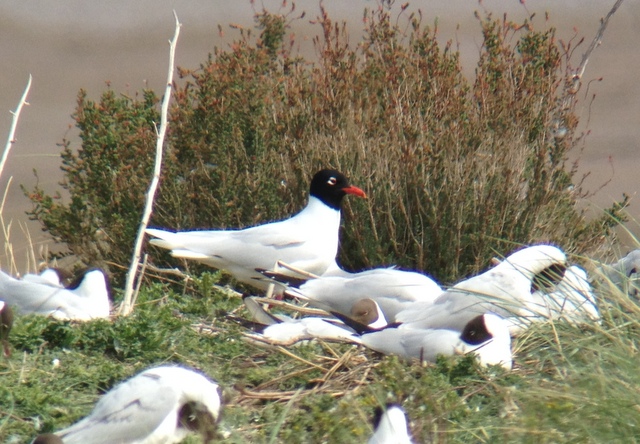 Mediterranean Gull – amongst the more numerous Black-headed Gulls
Mediterranean Gull – amongst the more numerous Black-headed Gulls
We wanted to finish the day at Titchwell. On the walk out onto the reserve, we stopped to admire a Reed Warbler singing from the reeds and a Sedge Warbler singing from the brambles.
There was a good selection of waders on the freshmarsh. One of the Little Ringed Plovers on the islands was close enough for us to get a good look at its golden yellow eye-ring. The Dunlin are coming into summer plumage, and most of them were sporting smart black belly patches, to varying degrees. A small group of Bar-tailed Godwit flew in, a mixture of grey winter birds and rusty summer ones, all obviously pushed off the beach by the rising tide, and a single grey Knot was in amongst them. A large flock of Turnstone also arrived, and several of those were looking particularly fine with their summer-plumage white faces and rust upperparts.
Out on the Thornham saltmarsh we picked up a Grey Plover. It too was getting some summer plumage, sporting a black belly but still a patchy black face. A Whimbrel ran across the far side of the Volunteer Marsh and disappeared into the vegetation on the bank – we just got to see its stripy head in the scope. Nearby, a single Curlew slept on the opposite bank. The only Black-tailed Godwits we saw today were a small flock of around 8 on the tidal pools – perhaps most of them have already set off back to Iceland. On the beach, with the tide coming in, there were fewer waders. A little flock of Sanderling flew in and started to scurry along the shore. There were also a couple of large groups of very noisy Oystercatcher.
 Avocet – no Titchwell post would be complete without one!
Avocet – no Titchwell post would be complete without one!
Wildfowl were also well represented. There are still lots of Brent Geese along the coast and a couple of hundred flew in from Thornham saltmarsh and splashed down on the freshmarsh. We paused to admire them through the scope. When most of them flew off again, a little group of 7 were left behind. A closer look confirmed they were a family party, 2 adults and 5 juveniles still just sporting a few remaining stripy wing coverts.
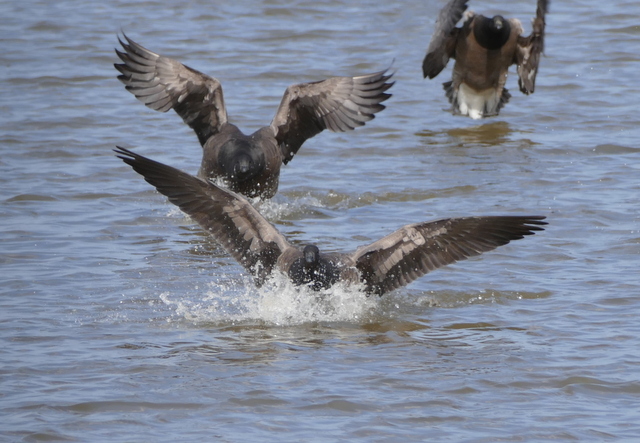 Brent Geese – splashdown on the freshmarsh
Brent Geese – splashdown on the freshmarsh
There was still a good smattering of dabbling ducks on show. Some intricately patterned Gadwall; lots of Teal, including the odd-looking presumed ‘intersex’ female Teal from the other day; no shortage of Mallard including several females with broods of small ducklings; and a good selection of big-billed Shoveler.
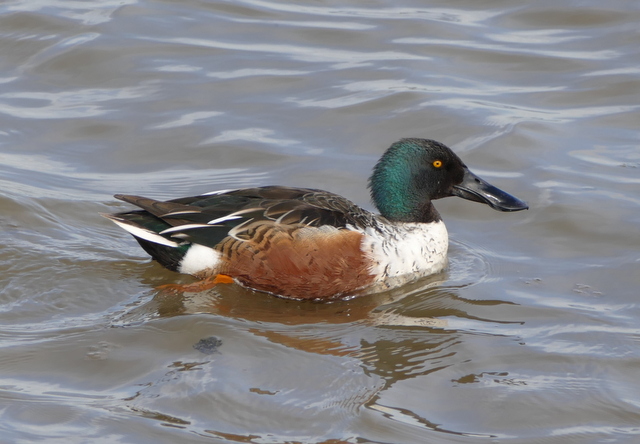 Shoveler – presumably a young drake, but still looking very smart
Shoveler – presumably a young drake, but still looking very smart
It had clouded over and the wind had swung round while we were out at the beach. As a consequence, it had grown noticeably cooler. We still just had enough time to have a quick look out at Patsy’s Reedbed. The pool held a good number of Red-crested Pochard, at least 12 in total, mostly drakes. We stopped to watch a Lesser Whitethroat, singing from the depths of a dense hawthorn hedge, which just showed itself briefly. But there was no sign of the Grasshopper Warbler in the cool wind.
Then it was time to call it a day – and a very successful one it had been, once again, with an excellent selection of spring migrants.
 Gadwall – a subtly-patterned drake, if a little dirty this one!
Gadwall – a subtly-patterned drake, if a little dirty this one!
















